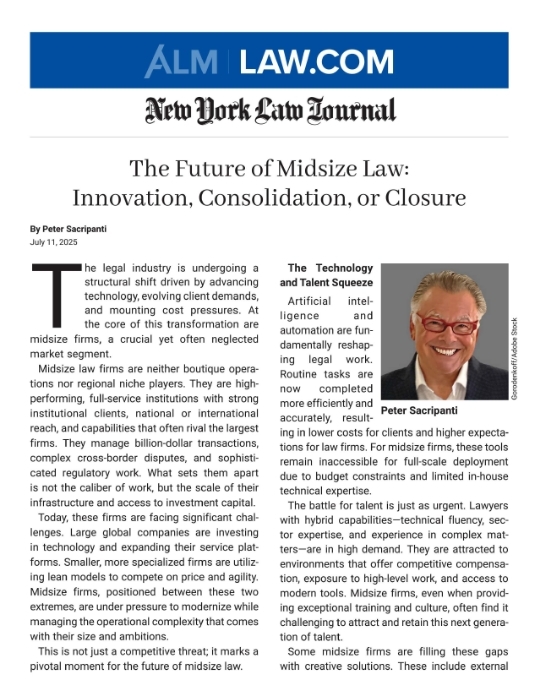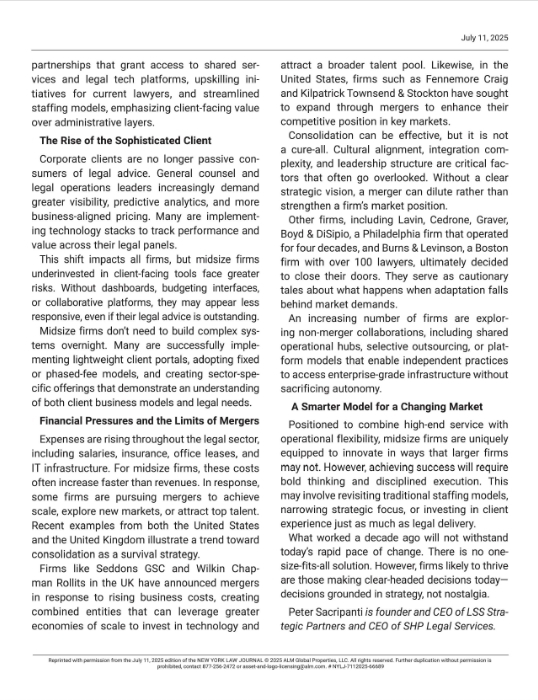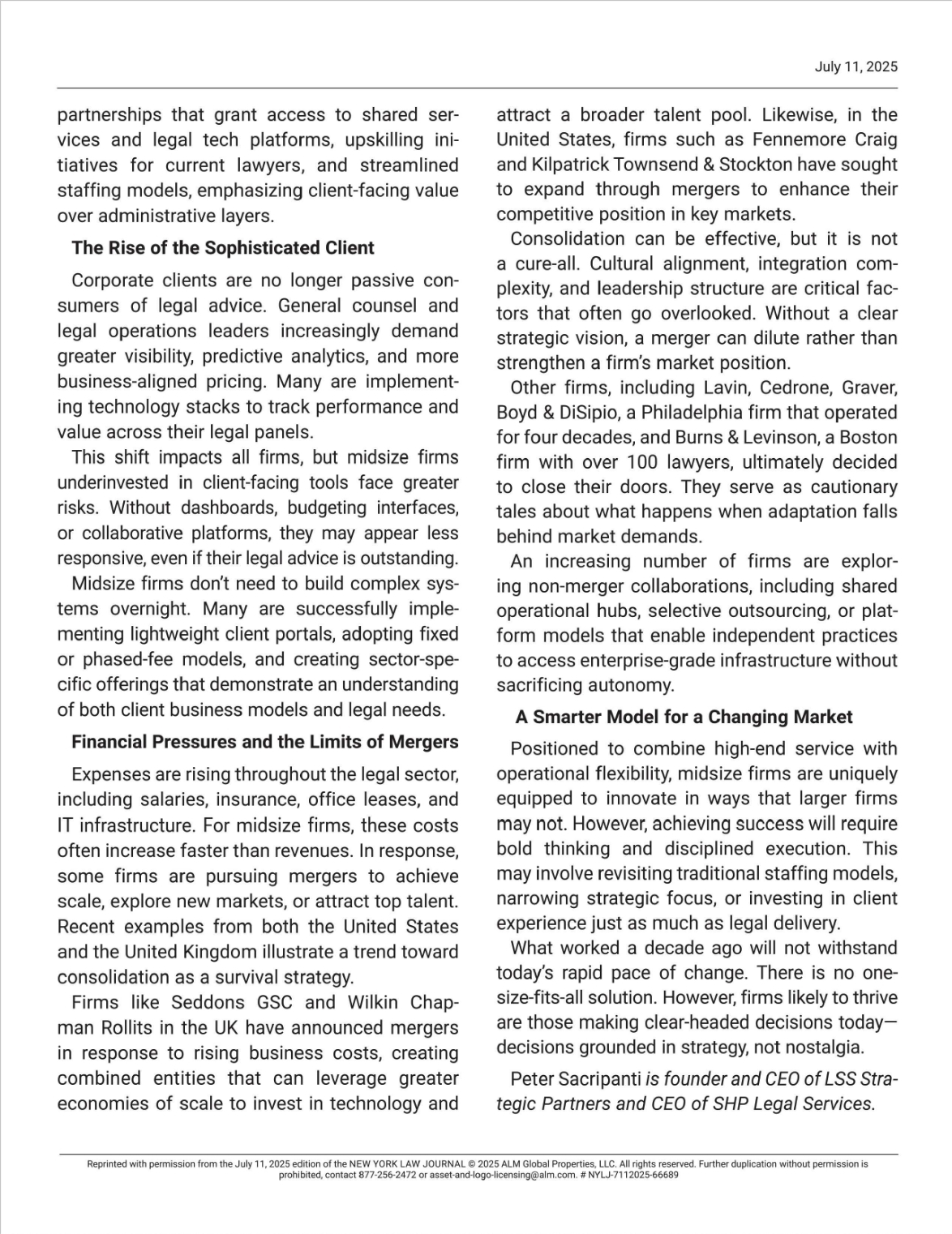The legal industry is undergoing a structural shift driven by advancing technology, evolving client demands, and mounting cost pressures. At the core of this transformation are midsize firms, a crucial yet often neglected market segment.
Midsize law firms are neither boutique operations nor regional niche players. They are high-performing, full-service institutions with strong institutional clients, national or international reach, and capabilities that often rival the largest firms. They manage billion-dollar transactions, complex cross-border disputes, and sophisticated regulatory work. What sets them apart is not the caliber of work, but the scale of their infrastructure and access to investment capital.
Today, these firms are facing significant challenges. Large global companies are investing in technology and expanding their service plat- forms. Smaller, more specialized firms are utilizing lean models to compete on price and agility. Midsize firms, positioned between these two extremes, are under pressure to modernize while managing the operational complexity that comes with their size and ambitions.
This is not just a competitive threat; it marks a pivotal moment for the future of midsize law.
The Technology and Talent Squeeze
Artificial intelligence a n d automation are fundamentally reshaping legal work. Routine tasks are now completed more efficiently and accurately, resulting in lower costs for clients and higher expectations for law firms. For midsize firms, these tools remain inaccessible for full-scale deployment due to budget constraints and limited in-house technical expertise.
The battle for talent is just as urgent. Lawyers with hybrid capabilities-technical fluency, sector expertise, and experience in complex matters are in high demand. They are attracted to environments that offer competitive compensation, exposure to high-level work, and access to modern tools. Midsize firms, even when providing exceptional training and culture, often find it challenging to attract and retain this next generation of talent.
Some midsize firms are filling these gaps with creative solutions. These include external partnerships that grant access to shared services and legal tech platforms, upskilling initiatives for current lawyers, and streamlined staffing models, emphasizing client-facing value over administrative layers.
The Rise of the Sophisticated Client
Corporate clients are no longer passive consumers of legal advice. General counsel and legal operations leaders increasingly demand greater visibility, predictive analytics, and more business-aligned pricing. Many are implement- ing technology stacks to track performance and value across their legal panels.
This shift impacts al firms, but midsize firms underinvested in client-facing tools face greater risks. Without dashboards, budgeting interfaces, or collaborative platforms, they may appear less responsive, even if their legal advice is outstanding.
Midsize firms don’t need to build complex systems overnight. Many are successfully implementing lightweight client portals, adopting fixed or phased-fee models, and creating sector-specific offerings that demonstrate an understanding of both client business models and legal needs.
Financial Pressures and the Limits of Mergers
Expenses are rising throughout the legal sector, including salaries, insurance, office leases, and TI infrastructure. For midsize firms, these costs often increase faster than revenues. In response, some firms are pursuing mergers to achieve scale, explore new markets, or attract top talent. Recent examples from both the United States and the United Kingdom illustrate a trend toward consolidation as a survival strategy.
Firms like Seddons GSC and Wilkin Chapman Rollits in the UK have announced mergers in response to rising business costs, creating combined entities that can leverage greater economies of scale to invest in technology and attract a broader talent pool. Likewise, in the United States, firms such as Fennemore Craig and Kilpatrick Townsend &Stockton have sought to expand through mergers to enhance their competitive position in key markets.
Consolidation can be effective, but it is not a cure-all. Cultural alignment, integration complexity, and leadership structure are critical fac- tors that often go overlooked. Without a clear strategic vision, a merger can dilute rather than strengthen a firm’s market position.
Other firms, including Lavin, Cedrone, Graver, Boyd & DiSipio, a Philadelphia firm that operated for four decades, and Burns &Levinson, a Boston firm with over 100 lawyers, ultimately decided to close their doors. They serve as cautionary tales about what happens when adaptation falls behind market demands.
An increasing number of firms are exploring non-merger collaborations, including shared operational hubs, selective outsourcing, or platform models that enable independent practices to access enterprise-grade infrastructure without sacrificing autonomy.
A Smarter Model for a Changing Market
Positioned to combine high-end service with operational flexibility, midsize firms are uniquely equipped to innovate in ways that larger firms may not. However, achieving success will require bold thinking and disciplined execution. This may involve revisiting traditional staffing models, narrowing strategic focus, or investing in client experience just as much as legal delivery.
What worked a decade ago will not withstand today’s rapid pace of change. There is no one size-fits-all solution. However, firms likely to thrive are those making clear-headed decisions today- decisions grounded in strategy, not nostalgia.
Peter Sacripanti is founder and CEO of LSS Strategic Partners and CEO of SHP Legal Services.



